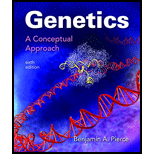
a.
To determine:
The most likely genotypes for the parents of each litter.
Introduction:
The ABO blood group is determined by three alleles of gene I:
If gene I encode for both molecule A and B, it give rise to blood group type AB (genotype
b.
To determine:
The most likely genotypes for the parents of each litter.
Introduction:
The ABO blood group is determined by three alleles of gene I:
If gene I encode for both molecule A and B, it give rise to blood group type AB (genotype
c.
To determine:
The most likely genotypes for the parents of each litter.
Introduction:
The ABO blood group is determined by three alleles of gene I:
If gene I encode for both molecule A and B, it give rise to blood group type AB (genotype
d.
To determine:
The most likely genotypes for the parents of each litter.
Introduction:
The ABO blood group is determined by three alleles of gene I:
If gene I encode for both molecule A and B, it give rise to blood group type AB (genotype
e.
To determine:
The most likely genotypes for the parents of each litter.
Introduction:
The ABO blood group is determined by three alleles of gene I:
If gene I encode for both molecule A and B, it give rise to blood group type AB (genotype
f.
To determine:
The most likely genotypes for the parents of each litter.
Want to see the full answer?
Check out a sample textbook solution
Chapter 3 Solutions
Genetics: A Conceptual Approach
 Human Anatomy & Physiology (11th Edition)BiologyISBN:9780134580999Author:Elaine N. Marieb, Katja N. HoehnPublisher:PEARSON
Human Anatomy & Physiology (11th Edition)BiologyISBN:9780134580999Author:Elaine N. Marieb, Katja N. HoehnPublisher:PEARSON Biology 2eBiologyISBN:9781947172517Author:Matthew Douglas, Jung Choi, Mary Ann ClarkPublisher:OpenStax
Biology 2eBiologyISBN:9781947172517Author:Matthew Douglas, Jung Choi, Mary Ann ClarkPublisher:OpenStax Anatomy & PhysiologyBiologyISBN:9781259398629Author:McKinley, Michael P., O'loughlin, Valerie Dean, Bidle, Theresa StouterPublisher:Mcgraw Hill Education,
Anatomy & PhysiologyBiologyISBN:9781259398629Author:McKinley, Michael P., O'loughlin, Valerie Dean, Bidle, Theresa StouterPublisher:Mcgraw Hill Education, Molecular Biology of the Cell (Sixth Edition)BiologyISBN:9780815344322Author:Bruce Alberts, Alexander D. Johnson, Julian Lewis, David Morgan, Martin Raff, Keith Roberts, Peter WalterPublisher:W. W. Norton & Company
Molecular Biology of the Cell (Sixth Edition)BiologyISBN:9780815344322Author:Bruce Alberts, Alexander D. Johnson, Julian Lewis, David Morgan, Martin Raff, Keith Roberts, Peter WalterPublisher:W. W. Norton & Company Laboratory Manual For Human Anatomy & PhysiologyBiologyISBN:9781260159363Author:Martin, Terry R., Prentice-craver, CynthiaPublisher:McGraw-Hill Publishing Co.
Laboratory Manual For Human Anatomy & PhysiologyBiologyISBN:9781260159363Author:Martin, Terry R., Prentice-craver, CynthiaPublisher:McGraw-Hill Publishing Co. Inquiry Into Life (16th Edition)BiologyISBN:9781260231700Author:Sylvia S. Mader, Michael WindelspechtPublisher:McGraw Hill Education
Inquiry Into Life (16th Edition)BiologyISBN:9781260231700Author:Sylvia S. Mader, Michael WindelspechtPublisher:McGraw Hill Education





